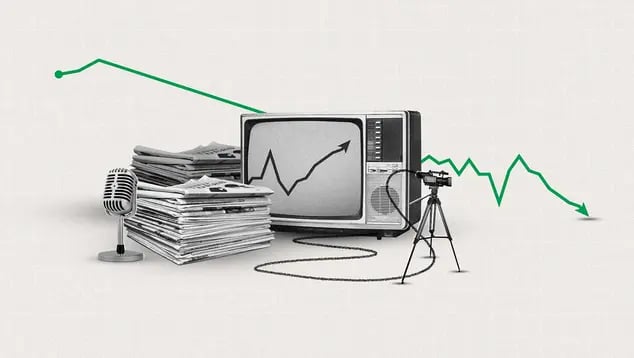The Long Decline: How Trust in Mainstream Media Collapsed
For much of the 20th century, Americans viewed the press as the Fourth Estate—a crucial pillar of democracy charged with holding power to account. Yet, as the Gallup data spanning from 1972 to 2025 vividly demonstrates, this faith has been steadily eroding.
Dr. Tarek Cherkaoui
5/8/20242 min read


For much of the 20th century, Americans viewed the press as the Fourth Estate—a crucial pillar of democracy charged with holding power to account. Yet, as the Gallup data spanning from 1972 to 2025 vividly demonstrates, this faith has been steadily eroding.
In the early 1970s, nearly seven in ten Americans (≈70%) said they had a great deal or fair amount of trust in mass media. By 2025, that number has fallen to just 36%, while 34% report having not very much trust and 28% admit to having no trust at all. The lines on the Gallup graph have crossed—signifying not just statistical change but a profound cultural shift.
Commercialization and the Decline of Objectivity
One of the root causes behind this steady collapse is the commercial transformation of journalism. Over time, economic imperatives eclipsed the public interest. The deregulation wave of the 1980s and 1990s opened the door to mass consolidation, leaving the U.S. media landscape dominated by just six conglomerates—Comcast, Walt Disney, Warner Bros. Discovery, Paramount Global, Sony, and Amazon—collectively controlling roughly 90% of all media outlets.
This concentration of ownership turned journalism into a profit-maximizing enterprise. Editorial independence increasingly gave way to corporate interests, ratings, and shareholder returns. The watchdog function once celebrated in the Watergate era was replaced by a lapdog model—a press that echoes rather than questions.
The Military-Industrial-Media Complex
The problem extends beyond boardrooms. As the military-industrial complex expanded its influence, so too did its grip on media narratives. Coverage of conflicts—from the Gulf War to Afghanistan, Iraq, and Gaza—has too often mirrored official talking points, blurring the line between national security reporting and state-sponsored messaging. In this ecosystem, dissenting perspectives are marginalized, and the press becomes a participant in, rather than a critic of, power.
Erosion of Journalistic Infrastructure
Another contributor has been the economic hollowing of the newsroom. Since the 2000s, traditional outlets have endured relentless budget cuts, staff reductions, and closures. Fewer reporters are tasked with covering more complex global issues, leaving space for sensationalism, punditry, and algorithmically driven “infotainment.”
The result: a public that senses imbalance and superficiality in coverage—especially concerning conflicts, foreign affairs, and politically sensitive topics.
Systemic Media Bias
The concept of media bias is no longer confined to partisan accusation; it is systemic. As scholars such as Hallin (1986) and Dickson (1994) argue, bias stems from structural conditions—ownership, advertising pressures, and political alignment—not merely individual journalist behavior. When government and corporate interests shape what counts as “newsworthy,” reporting ceases to challenge power and instead serves it.
This dynamic corrodes credibility: citizens recognize selective reporting and emotional framing as manipulative, not enlightening. Consequently, trust declines, not because audiences reject truth, but because they no longer believe they are being told it.
The Meaning of the Gallup Trend
The Gallup poll’s trajectory reflects more than waning confidence—it signals the collapse of the postwar media consensus. Where once Americans turned to mainstream outlets for reliable narratives, they now turn to fragmented, polarized digital ecosystems.
The result is a paradox: an era of unprecedented information access coinciding with unprecedented mistrust.
Restoring credibility will require more than nostalgia for a bygone “golden age.” It demands putting some brakes over media ownership, investment in investigative journalism, transparency in news production, and above all, a renewed commitment to truth over profit.
Until then, the story of American media remains one of slow decay—from the Fourth Estate to a fractured landscape where the very notion of objective journalism is up for debate.